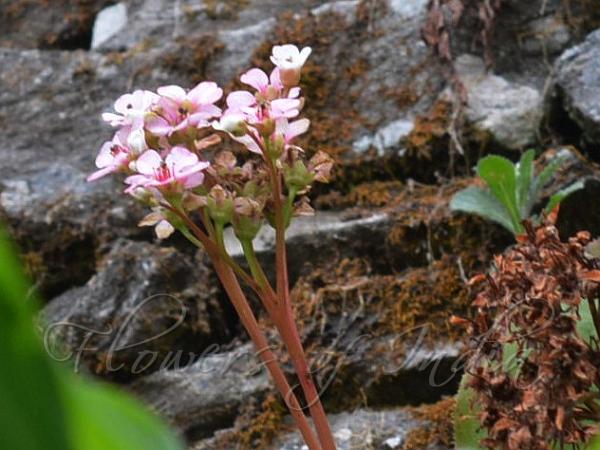|
| Chinese Bergenia |
|

|

| File size | 128189 |
| Original date | 4/21/17 9:38 AM |
| Resolution | 0 x 0 |
| Flash | Flash did not fire, auto |
| Focal length | 60.0mm |
| Exposure time | 1/125s |
| Aperture | 4.5 |
| Focus Distance | |
| Metering Mode | Multi-segment |
| Camera make | NIKON CORPORATION |
| Camera model | NIKON D3200 |
| Sensor type | OneChipColorArea |
|
|
|
|
Photo: |
Botanical name: Bergenia pacumbis Family: Saxifragaceae (Saxifrage family)
Synonyms: Bergenia himalaica Boriss., Bergenia ligulata, Bergenia ciliata f. ligulata
Synonyms: Bergenia himalaica Boriss., Bergenia ligulata, Bergenia ciliata f. ligulata
Chinese Bergenia is a perennial herb, about 17 cm
tall. Rhizomes are thick, scaly. Leaves are all at the base, leaf-stalk
3-10 cm or longer, blade round or broadly ovate to broadly obovate,
7-15 x 6.6-13.2 cm, leathery, both surfaces hairless, base rounded,
margin entire or obscurely rounded toothed, rigidly fringed with hairs,
tip blunt. White-pink flowers are borne in cymes, about 7.5 cm;
branches and flower-stalks sparsely glandular. Hypanthium is sparsely
glandular hairy. Sepals are spreading, broadly ovate, 3-3.5 mm,
leathery, hairless, veins many, apical margin sometimes sparsely
toothed. Petals are white or pink, round, about 8.5 x 6 mm, veins many,
base narrowed into a claw about 2 mm, tip blunt. Stamens are about 5.5
mm. Chinese Bergenia is found in fForests, rock crevices, at altitudes
of 2300-2400 m, in the Himalayas, from Afghanistan,Kashmir, Nepal to
Bhutan, NE India. Flowering: June-August.
Medicinal uses: The root of Chinese Bergenia
is rich in tannins and is used as a tonic in the treatment of fevers,
diarhoea and pulmonary affections. The root has a high reputation in
indigenous systems of medicine for dissolving stones in the kidneys.
The root is bruised and applied externally to treat boils and
ophthalmia.
The root of Chinese Bergenia
is rich in tannins and is used as a tonic in the treatment of fevers,
diarhoea and pulmonary affections. The root has a high reputation in
indigenous systems of medicine for dissolving stones in the kidneys.
The root is bruised and applied externally to treat boils and
ophthalmia.
Medicinal uses:
 The root of Chinese Bergenia
is rich in tannins and is used as a tonic in the treatment of fevers,
diarhoea and pulmonary affections. The root has a high reputation in
indigenous systems of medicine for dissolving stones in the kidneys.
The root is bruised and applied externally to treat boils and
ophthalmia.
The root of Chinese Bergenia
is rich in tannins and is used as a tonic in the treatment of fevers,
diarhoea and pulmonary affections. The root has a high reputation in
indigenous systems of medicine for dissolving stones in the kidneys.
The root is bruised and applied externally to treat boils and
ophthalmia. | Identification credit: Saroj Kasaju | Photographed in Soureni, Mirik, West Bengal. |
• Is this flower misidentified? If yes,